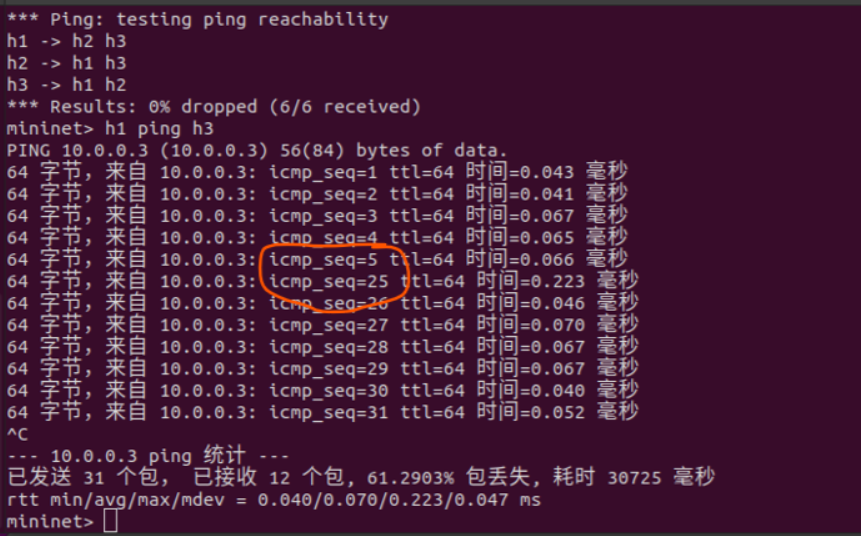实验7:基于REST API的SDN北向应用实践
一、基本要求:
①、编写Python程序,调用OpenDaylight的北向接口实现以下功能:
0、利用Mininet平台搭建下图所示网络拓扑,并连接OpenDaylight;

1、删除s1上的流表数据代码及其截图:
点击查看代码
#!/usr/bin/python
import requests
from requests.auth import HTTPBasicAuth
def http_delete(url):
url= url
headers = {'Content-Type':'application/json'}
resp = requests.detele(url,headers=headers,auth=HTTPBasicAuth('admin', 'admin'))
print (resp.content)
if __name__ == "__main__":
url = 'http://127.0.0.1:8181/restconf/config/opendaylight-inventory:nodes/node/openflow:1/'
http_delete(url)

2、硬超时代码及其截图:
点击查看代码
#硬超时json代码修改
{
"flow": [
{
"id": "1",
"match": {
"in-port": "1",
"ethernet-match": {
"ethernet-type": {
"type": "0x0800"
}
},
"ipv4-destination": "10.0.0.3/32"
},
"instructions": {
"instruction": [
{
"order": "0",
"apply-actions": {
"action": [
{
"order": "0",
"drop-action": {}
}
]
}
}
]
},
"flow-name": "flow1",
"priority": "65535",
"hard-timeout": "20",
"cookie": "2",
"table_id": "0"
}
]
}
点击查看代码
#!/usr/bin/python
import requests
from requests.auth import HTTPBasicAuth
def http_timeout(url,str):
url= url
headers = {'Content-Type':'application/json'}
resp = requests.put(url,str,headers=headers,auth=HTTPBasicAuth('admin', 'admin'))
print (resp.content)
if __name__ == "__main__":
url = 'http://127.0.0.1:8181/restconf/config/opendaylight-inventory:nodes/node/openflow:1/flow-node-inventory:table/0/flow/1'
with open("./timeout.json") as file:
str = file.read()
http_timeout(url,str)


3、获取s1上活动的流表数代码及其截图:
点击查看代码
#!/usr/bin/python
import requests
from requests.auth import HTTPBasicAuth
def http_get(url):
url= url
headers = {'Content-Type':'application/json'}
resp = requests.get(url,headers=headers,auth=HTTPBasicAuth('admin', 'admin'))
print (resp.content)
if __name__ == "__main__":
url = 'http://127.0.0.1:8181/restconf/operational/opendaylight-inventory:nodes/node/openflow:1/flow-node-inventory:table/0/opendaylight-flow-table-statistics:flow-table-statistics'
http_get(url)

②、编写Python程序,调用Ryu的北向接口实现以下功能:
1、实现上述OpenDaylight实验拓扑上相同的硬超时流表下发。
点击查看代码
#!/usr/bin/python
import requests
def http_timeout(url,str):
url= url
headers = {'Content-Type':'application/json'}
resp = requests.post(url,str,headers=headers)
print (resp.content)
if __name__ == "__main__":
url = 'http://127.0.0.1:8080/stats/flowentry/add'
with open("./032002225_timeout.json") as file:
str = file.read()
http_timeout(url,str)
点击查看代码
{
"dpid": 1,
"cookie": 1,
"cookie_mask": 1,
"table_id": 0,
"hard_timeout": 20,
"priority": 65535,
"flags": 1,
"match":{
"in_port":1
},
"actions":[
]
}
ryu-manager ryu.app.simple_switch_13 ryu.app.ofctl_rest


2、参考Ryu REST API的文档,基于VLAN实验的网络拓扑,编程实现相同的VLAN配置。
建立拓扑:sudo mn --custom topo.py --topo mytopo --mac --controller=remote,ip=127.0.0.1,port=6633 --switch ovs,protocols=OpenFlow13
点击查看代码
from mininet.topo import Topo
class MyTopo(Topo):
def __init__(self):
# initilaize topology
Topo.__init__(self)
self.addSwitch("s1")
self.addSwitch("s2")
self.addHost("h1")
self.addHost("h2")
self.addHost("h3")
self.addHost("h4")
self.addLink("s1", "h1")
self.addLink("s1", "h2")
self.addLink("s2", "h3")
self.addLink("s2", "h4")
self.addLink("s1", "s2")
topos = {'mytopo': (lambda: MyTopo())}
点击查看代码
import json
import requests
if __name__ == "__main__":
url = 'http://127.0.0.1:8080/stats/flowentry/add'
headers = {'Content-Type': 'application/json'}
flow1 = {
"dpid": 1,
"priority": 1,
"match":{
"in_port": 1
},
"actions":[
{
"type": "PUSH_VLAN",
"ethertype": 33024
},
{
"type": "SET_FIELD",
"field": "vlan_vid",
"value": 4096
},
{
"type": "OUTPUT",
"port": 3
}
]
}
flow2 = {
"dpid": 1,
"priority": 1,
"match":{
"in_port": 2
},
"actions":[
{
"type": "PUSH_VLAN",
"ethertype": 33024
},
{
"type": "SET_FIELD",
"field": "vlan_vid",
"value": 4097
},
{
"type": "OUTPUT",
"port": 3
}
]
}
flow3 = {
"dpid": 1,
"priority": 1,
"match":{
"vlan_vid": 0
},
"actions":[
{
"type": "POP_VLAN",
"ethertype": 33024
},
{
"type": "OUTPUT",
"port": 1
}
]
}
flow4 = {
"dpid": 1,
"priority": 1,
"match": {
"vlan_vid": 1
},
"actions": [
{
"type": "POP_VLAN",
"ethertype": 33024
},
{
"type": "OUTPUT",
"port": 2
}
]
}
flow5 = {
"dpid": 2,
"priority": 1,
"match": {
"in_port": 1
},
"actions": [
{
"type": "PUSH_VLAN",
"ethertype": 33024
},
{
"type": "SET_FIELD",
"field": "vlan_vid",
"value": 4096
},
{
"type": "OUTPUT",
"port": 3
}
]
}
flow6 = {
"dpid": 2,
"priority": 1,
"match": {
"in_port": 2
},
"actions": [
{
"type": "PUSH_VLAN",
"ethertype": 33024
},
{
"type": "SET_FIELD",
"field": "vlan_vid",
"value": 4097
},
{
"type": "OUTPUT",
"port": 3
}
]
}
flow7 = {
"dpid": 2,
"priority": 1,
"match": {
"vlan_vid": 0
},
"actions": [
{
"type": "POP_VLAN",
"ethertype": 33024
},
{
"type": "OUTPUT",
"port": 1
}
]
}
flow8 = {
"dpid": 2,
"priority": 1,
"match": {
"vlan_vid": 1
},
"actions": [
{
"type": "POP_VLAN",
"ethertype": 33024
},
{
"type": "OUTPUT",
"port": 2
}
]
}
res1 = requests.post(url, json.dumps(flow1), headers=headers)
res2 = requests.post(url, json.dumps(flow2), headers=headers)
res3 = requests.post(url, json.dumps(flow3), headers=headers)
res4 = requests.post(url, json.dumps(flow4), headers=headers)
res5 = requests.post(url, json.dumps(flow5), headers=headers)
res6 = requests.post(url, json.dumps(flow6), headers=headers)
res7 = requests.post(url, json.dumps(flow7), headers=headers)
res8 = requests.post(url, json.dumps(flow8), headers=headers)


二、进阶要求
三、个人总结
这个实验算是综合能力比较强的实验,在基本要求第一点就结合了实验4的内容,第二点结合了之前许多的小实验,特别是第二点,刚开始我忘记了得用ryu-manager ryu.app.simple_switch_13 ryu.app.ofctl_rest去连接ryu,导致一直pingall不了,然后用了这段代码之后又出了这样那样的问题,貌似是python的版本下载太多虚拟机分不清了。最后实在没有办法,在舍友的建议下重启虚拟机,结果就OK了,属实是难以理解。而后同学好心提醒了一下,才知道要用curl来删除流表才能继续PING,让我晕头转向。
对我来说,这次实验有较大的难度,综合性很强,让我对ODL和ryu有了更深的了解。


